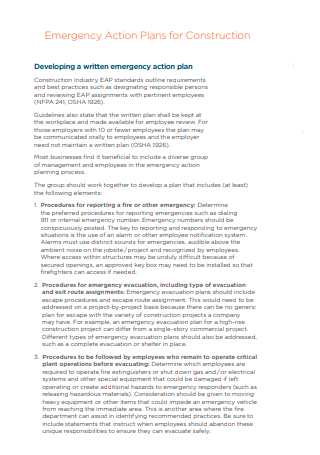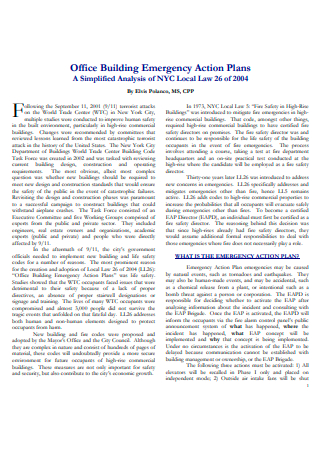14+ Sample Construction Emergency Action Plan
-

Construction Emergency Action Plan Template
download now -

Draft Construction Emergency Action Plan
download now -

Construction Emergency Action Plan Example
download now -

Standard Construction Emergency Action Plan
download now -

Construction Emergency Action Plan in PDF
download now -

Temporary Construction Emergency Action Plan Template
download now -

Office Building Construction Emergency Action Plan
download now -

Basic Construction Emergency Action Plan
download now -

Engineering and Construction Emergency Action Plan
download now -

Construction Sites Emergency Action Planning
download now -

Printable Construction Emergency Action Plan
download now -

Building Construction Emergency Action Plan
download now -

Construction Projects Emergency Response Action Plan
download now -

Formal Construction Emergency Action Planning
download now -

Construction Dam Emergency Action Plan
download now
FREE Construction Emergency Action Plan s to Download
14+ Sample Construction Emergency Action Plan
What is a Construction Emergency Action Plan?
What are the Elements of a Construction Emergency Action Plan?
Emergency Procedures in Dealing With Accidents in the Construction Site
Common Accidents in a Construction Site
How to Prepare a Construction Emergency Action Plan?
FAQs
What are the categories of workplace emergencies?
What are the hazardous substances that can be found on a construction site?
Should you alert authorities to any kind of emergency?
What is a Construction Emergency Action Plan?
An emergency action plan is a work document that is written in accordance with OSHA (Occupational Safety and Health Administration) standards. Its purpose is to facilitate and organize the actions that the employee and employer will take whenever an emergency happens in a workplace. A construction emergency action plan establishes a detailed organizational structure for response to emergencies in a construction workplace. It also assigns roles and responsibilities for the implementation of the plan during an emergency. For a construction emergency action plan to work effectively, it needs to be well-developed, and proper emergency training of the construction workers (for them to understand their respective roles and responsibilities in the action plan) must be carried out. An effective action plan results in fewer and less severe injuries and less structural damage to the construction facility whenever emergencies occur.
What are the Elements of a Construction Emergency Action Plan?
A proper construction emergency action plan put in place enables the employees to properly follow it and enables the operations to quickly get back on track should an emergency occur. It also helps the construction workers take fast and effective action should disaster strike, and eases the severity of the emergency situation, and also acts as a consequence limitation. In making a construction emergency action plan, it is important to take note of the following elements:
Emergency Procedures in Dealing With Accidents in the Construction Site
Here are the appropriate procedures to observe in case something untoward happens in the construction site:
- Chemical spillage – In case of any dangerous chemicals being spilled on the construction site, the emergency coordinator should be immediately notified. In terms of cleanup, the procedure can only be done by trained personnel in the workplace. When cleaning up the waste, it should be noted that proper personal protective equipment must be always worn. In case of the absence of trained personnel, it is okay to outsource help from a specialized company.
- Medical Emergencies – The paramedics who are responding to the emergency should be given the necessary information about the nature and cause of the emergency and the location of the workplace where the emergency happened. In addition to that, the construction workers should also have proper first aid and CPR (Cardiopulmonary Resuscitation) training should the arrival of any external help be delayed.
- Fire Emergencies – Should a fire break out inside the construction site, activate the fire alarm system and immediately notify the fire department of the incident, and call for emergency assistance. If the fire is still small and has not spread out, use the appropriate firefighting equipment. If evacuation is necessary, the proper procedures should be followed.
- Structural – Accidents that involve standing or temporary structures in the construction site such as scaffoldings can be life-threatening. It is important that all structures that are installed on the site must be listed and the emergency plans that are specific to the structure must be developed. The workers assigned on or near the structures must be also familiar with the emergency procedures.
Common Accidents in a Construction Site
Since a construction site contains many moving elements, such as heavy equipment and moving personnel, as well as having many temporary installations present, it is no stranger to accidents. Here are the most common ones:
How to Prepare a Construction Emergency Action Plan?
Emergency action plans provide strategies to combat specific situations and assign responsibilities for implementation that any worker on the construction site must follow during an emergency situation. With that being said, here are the steps you can follow in preparing an effective construction emergency action plan:
Step 1: Familiarize every possible scenario.
The first step in creating an emergency action plan is to identify the types of emergencies that can occur on the construction site. It includes various hazards, from fire hazards, electrical hazards, foreign objects, to something as extreme as possible terrorist activities. It is important to not limit your response planning within the company’s boundaries, as there are some external factors that can also contribute to emergencies. In writing an emergency action plan for the construction site, you also need to consider how each unique scenario impacts the workplace and list all possible effects it has.
Step 2: Identify what to do and list down the tasks.
Understanding and identifying the various emergencies the construction site can experience helps with determining the appropriate actions you want the workers to take. Nothing is simple, and you cannot just tell your employees to pack up and leave when everything seems chaotic. Clearly defining the possible and suitable response also helps with their safety. You should also list here the steps that the workers should do should an emergency take place. In writing down the tasks, it is important to make them as simple and achievable as possible.
Step 3: Designate assembly points and familiarize the optimal evacuation routes.
Designating safe assembly locations where the construction workers meet after an evacuation is of utmost importance. Also, creating alternative assembly points is recommended in certain situations wherein the primary assembly point is deemed too hazardous or has been compromised by the accident. Aside from an alternate assembly point, include various routes in case the pathways are blocked or unsafe. Having these secure locations is useless if your employees cannot reach them or if they suffer injuries along the way. It is important to double-check all the evacuation routes toward the assembly points created frequently to avoid possible obstructions and ensure that the pathway remains safe.
Step 4: Always account for every worker.
Create an effective system that guarantees every worker on the construction site is well accounted for after an immediate evacuation. You can assign team leaders for each floor to have a list of workers for verification once everyone has arrived at the designated assembly point. For locations that use access cards or security verifications, guarantee real-time records for faster validation. One of the best ways to account for everyone is through implementing the buddy system, wherein the workers pair up with one another and are responsible for knowing the other’s location.
Step 5: Create an appropriate response drill.
The best way of doing response drills is to create a schedule. It is difficult to propose a response drill if every worker on-site is busy finishing up projects or work quotas. Before issuing the exercise, take note of the location and the number of participants joining. If setting up drills is out of the question, holding a meeting with small teams within the construction site and discussing the appropriate evacuation plans can serve as an effective alternative approach. In doing so, you can emphasize the importance of evacuation. It also serves as a way to help the workers understand their roles of being gathered at a safe area during an emergency.
FAQs
What are the categories of workplace emergencies?
Here are the three categories of workplace emergencies:
Emergencies Outside the Building – this refers to weather-related emergencies and natural disasters, such as typhoons, earthquakes, tornadoes, and hailstorms. These kinds of events have varying levels of warning and danger, so it is important that all workers know how to deal with them.
Emergencies Within the Building – this refers to emergencies that occur inside the workplace, such as power outages, fires, or an active shooter or criminal in the building. The main goal of dealing with this emergency is to get everyone out safely. Having a good knowledge of the workplace and the evacuation routes is essential for the staff to anticipate any unforeseen detours during evacuation.
Health Emergencies – this refers to emergencies that are related to someone’s health, such as heart attacks, seizures, getting injured in the workplace, broken bones, etc. Depending on the severity of the emergency, local emergency services may be contacted.
What are the hazardous substances that can be found on a construction site?
Here are the different types of hazardous substances in a construction site. Their sources can come externally or internally.
- biological hazards
- corrosive hazards
- explosive hazards
- flammable hazards
- toxic hazards
- in rare cases, radioactive hazards
- oxidizable hazards
Should you alert authorities to any kind of emergency?
In most scenarios, workplace emergencies can necessitate having to call the appropriate authorities, such as the fire and rescue department, emergency medical services, or the police department. It is also important to designate someone in the workplace to make the call to the authorities should an emergency arise. With that being said, an effective emergency action plan must list all the emergency numbers from external help so they can easily be contacted whenever they are needed.
Working in a construction site usually means difficult work is always faced throughout your shift. Aside from the difficulties faced, it is also dangerous. An effective construction emergency action plan helps the workers on the site take quick and effective action in case a disaster happens at the workplace. In turn, it lessens the severity of the emergency situation. In this article, examples of an effective action plan regarding construction emergencies are presented above for you to personally use as a reference if you need to create one.
